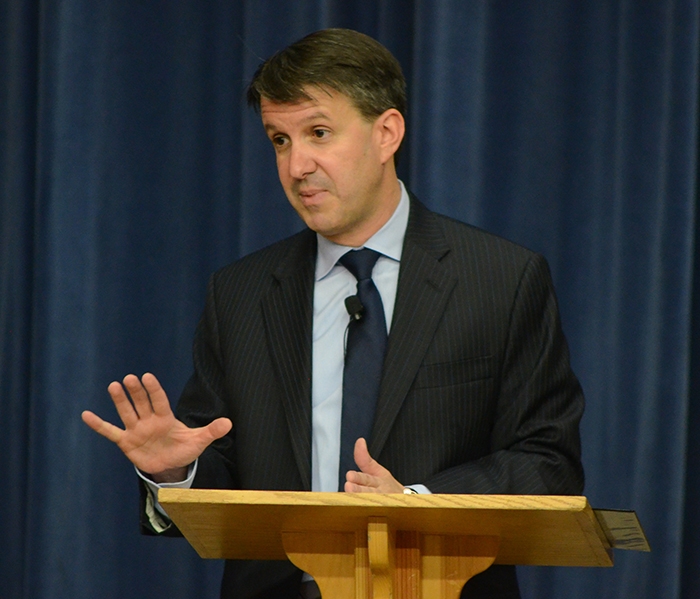Guest Speaker Says the Media Misleads the Public about Higher Education

MIDDLEBURY, Vt. – Journalist Jeffrey Selingo, a leading analyst of trends in higher education, said public perceptions about college education in America today are skewed by the mainstream media and popular culture.
Speaking at Middlebury College on May 9 for the Robert W. van de Velde ’75 Memorial Lecture Series, the former editor at the Chronicle of Higher Education discussed what those misperceptions are and explained how they originated.
The first of May has been dubbed “college decision day” by media outlets, Selingo said, which is “just another peg for the national media to write about how difficult it is to get into college these days.” The Washington Post compared the admissions process to the “Hunger Games”; Huffington Post advised teens to “use rejection to prepare for college”; and the New York Times headline said greater competition for college admission “means higher anxiety too.”
The media make it seem like “every year is the most selective year ever,” but the reality is “the average acceptance rate for four-year colleges has remained stable at around 65% for many years,” Selingo said. “Despite the headlines, it actually is not harder to get into college these days for the vast majority of American college-bound students.”
The speaker cited data showing:
- more than 75 percent of American undergraduates attend a college or university that accepts 50 percent or more of all of its applicants;
- half of American college students today attend community college;
- the majority of American undergrads attend school on a part-time basis;
- only 20 percent go fulltime to four-year, residential colleges; and
- 80 percent attend public colleges and universities.
So while elite private colleges and universities are seeing an increase in the number of applicants and realizing a lower acceptance rate, the truth is that American higher education today is not defined by what’s taking place at Harvard or M.I.T., Selingo said.
And why is that so?
“Because that’s what it looks like to the national news media. That’s where the national news media went to school. The news rooms of national publications and network news are filled with graduates of elite, mostly private four-year colleges, and yet nearly half of American students today attend community colleges!”
Over the last decade the national media is missing “the biggest story in higher education because it’s happening at public universities, and it’s the widespread disinvestment by states in public colleges and universities. Public colleges in the U.S. were once viewed as worthy of a collective investment for the greater good, and today they are seen as something for a private gain,” Selingo lamented.
He presented data showing the decline in state support for higher education. More than 30 states spend less on public higher education now than they did before the Great Recession of 2008, and some analysts are predicting that more than half of the states will be “out of the business of public higher education by the year 2050.”
Public universities are being forced to make up for the decline in appropriations by attracting out-of-state students and international students willing to pay higher fees than in-state students. Currently, Selingo said, 43 out of 50 “state flagship universities” enroll fewer in-state freshmen than out-of-state freshmen, thus “it’s no wonder that when you talk to average state residents about their public universities, they do not think those universities serve them.”
The media is also misleading the public about why students are going to college today because age and enrollment status are not the only factors to consider, the guest speaker noted.
Selingo analyzed 3,000 undergraduates over a two-year period and determined there are “mindsets and motivations for going to college that are often not captured in media reports about higher education today, nor are those mindsets and motivations considered by many colleges that still offer a one-size-fits-all degree. As a result, colleges and universities end up serving students in ways that are convenient for the institution, rather than meeting the needs of the students, and once again,” he said, “the press has not necessarily covered this.”
During his 60-minute talk Selingo also touched upon the high cost of higher education, the amount of student debt, how income inequality affects who goes to college, and how the college rankings (most notably that of U.S. News & World Report) place an undue emphasis on “input measures” such as retention rates and endowment, rather than “outputs” like job placements or the tangible skills gained by graduates.
Jeffrey Selingo’s talk was titled “Higher Education: How the Press Shapes the Private Gains over the Public Good,” and his latest book is called “There Is Life After College” (William Morrow: 2016). The van de Velde Lecture Series is supported by the van de Velde family and recent speakers include Bob Herbert and Rachel Donadio of the New York Times, David Wessel of the Wall Street Journal, and Jonathan Alter of Newsweek.
With reporting and photos by Robert Keren.

